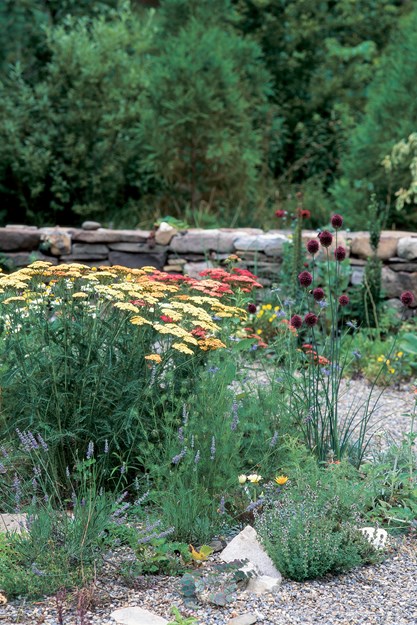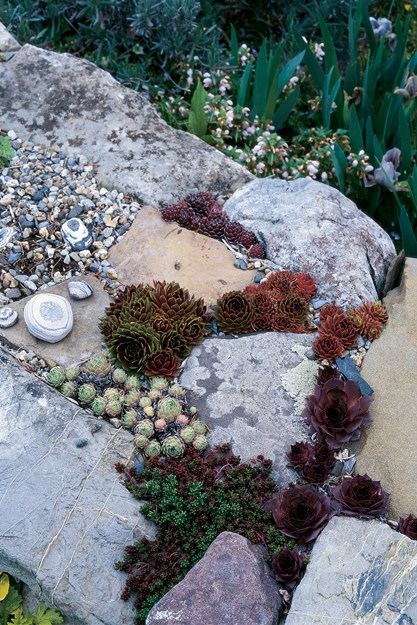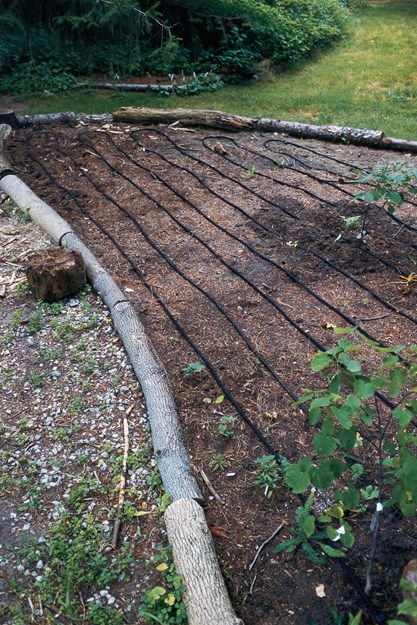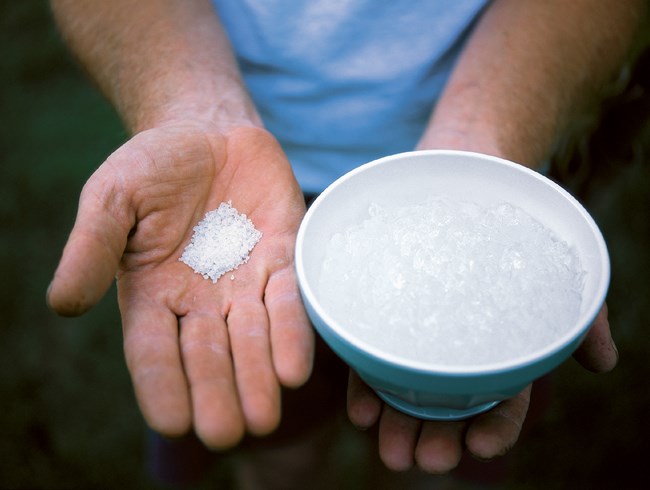
Where I grew up in central New Jersey, lawn sprinklers were for running through. We rarely thought of using them to irrigate the garden. Now I live in the northwest corner of the state with rivers, mountains and lakes. There’s water, water everywhere—including a river that splits to flow around my property and a canal bisecting it. But the irony is that there still isn’t enough water. We have had serious droughts for five of the past six years. Last year, we had the worst drought in recorded history.

The gravel garden was originally planned as a heat sink to trap the warmth of the sun and radiate it back to plants that didn’t grow well in the shaded river valley. Here the yellow and orange tones of yarrow mingle with lavender, thyme and the burgundy globes of Allium sphaerocephalon. The soil mix is half crushed stone and half clayey loam. Most of the plants went in during the summer of the worst drought. Druse worked hard to get them established, before water-use restrictions were in place. A year later, he is finding that the garden will not need watering at all, thanks to the tolerance of the plants. That is, of course, unless the region experiences another serious drought. Photo by: Ken Druse.
ADAPT TO SURVIVE
I came late to drought gardening. Much of the country has suffered similar dry spells in the recent past, especially California, where drastic water restrictions came into force in the 1970s and 1990s, leading to ongoing battles over who gets the limited supply. Despite the rain in May, the Northeast has remained in a declared drought emergency that won’t be lifted until reservoirs return to normal. We are not allowed to wash cars or water lawns, and can only use hand-held devices like watering cans and hoses to water new plantings and gardens.
In reaction to these restrictions, I took a series of measures. I hooked up a rain barrel, the rage in all the catalogs but mostly a symbolic gesture. I go through the 55 gallons the barrel holds quickly, and if you consider how much water runs down the spout, the little barrel holds only a fraction of it. An inch of rainfall on a 1,000-square-foot roof equals around 750 gallons. Now I want a million-gallon cistern dug under the house.
I never have watered the lawn on the island. I wouldn’t. Lawn can take drought. Turfgrass plants go dormant during dry spells. But my lawn doesn’t resemble a velvet putting green. It is a mix of anything that will tolerate mowing. Most of its plants are what people buy herbicides to kill in their lawns. I set the mower blades high and, by not bagging the clippings, let them return to the lawn. (Discover other eco-friendly lawn alternatives.)
SOIL STRATEGIES
When coping with drought, my principal strategy is to get the water into the ground, hold it there and keep it in the soil for as long as possible. Much of the island is floodplain and has very sandy soil. So I add humus in the form of compost all the time—every spring and whenever I plant anything. The sand eats it. I add more.

The 72-foot-long native stone wall around the gravel garden was built in a reverse question mark shape by Ken Druse’s neighbor, Chris Hagler. As the wall was being built, Druse inserted seedlings in tube socks of soil. He found this method helped to develop a good root system, which is vital to survival. Sempervivum (hens and chicks) and sedum flourish in dry nooks and crannies where other plants couldn’t survive. Other plants that do well are campanula, alpine dianthus and Phlox subulata. Photo by: Ken Druse.
To keep the soil cool and moist, I mulch. Even the gravel garden has a mulch—a 1- to 3-inch layer of crushed stone over the soil. The other beds are mulched mostly with chopped leaves. In some places, to suppress weeds I lay wet corrugated cardboard, which is always in great supply, and cover that with chopped leaves or wood chips. There are other ways of protecting the soil, too. For example, my driveway is gravel rather than asphalt to let the water percolate into the earth. There is no mortared stone for that same reason. Pavers, where they exist, are set in sand.
DELIVER WATER TO ROOTS
Most plants would love an inch of water per week, but that would be hard to supply with a garden hose or a hand-held sprayer. Watering from above usually leads to quite a loss through evaporation. This shallow irrigation can do more harm than good because it encourages roots to grow near the surface of the soil, where they are most susceptible to drought damage. That’s why I laid in-ground soaker hose (buried up to 3 inches deep) wherever possible. This delivers moisture directly to the roots where it is needed. Plants are not knocked to the ground by the weight of the water or the force from pulsating impulse sprinklers.

The system of buried soaker hoses laid out in a new border before planting. Photo by: Ken Druse.
Soaker hoses, for the uninitiated, are made from recycled rubber tires and are porous along their length. These slowly “weep” water into the soil. It’s best to lay a soaker hose in warm weather when the hose is more flexible and, ideally, before the plants go in. Typical spacing between hoses is about 18 inches; lay hoses closer together in sandy soil, farther apart in clay. Keep a hose-repair kit at hand in case you accidentally damage the hose when digging. I used plastic pegs to help in the laying and can usually find them when it is time to plant.
GIVE PLANTS A GOOD START
In general, native plants survive the odd swings in weather better than nonnatives. Around the outer edges of the property, I grow native trees and shrubs that originated in this area—like sugar maple and shag-bark hickory. They survive without extra water, but these, too, were carefully established when planted in the early days. Trees get careful watering the first year. I’ve used water-filled bags around their trunks to provide moisture for a week at a time. The specially designed reservoir bags release the water slowly. You can buy them from gardening catalogs or Web sites. I also water with recycled 1-gallon plastic jugs. I fill the jug with water, replace the cap and then poke a little nail hole or two in the bottom to let the water slowly drip out for a plant that needs a little extra watering.
A SWELL IDEA
I often use water-holding polymer gel when planting perennials in areas that I hope to avoid watering. Polymer gel crystals look like kosher salt and swell to many times their original size when moistened. They hold water and return it slowly to the soil. I hydrate the crystals and add the already swollen gel to excavated soil. Follow directions carefully. It is hard to believe that about a teaspoon of crystals will swell up to about a pint of material, but it will. I made the mistake of not believing this and planted a container only to have it erupt like Vesuvius every time it rained, all summer.

One teaspoon of polymer crystals makes a generous bowlful of water-holding gel. After digging a planting hole, Druse mixes the hydrated crystals into the excavated soil and backfills deep around the plant. This helps new plants get established and cuts down on future watering. The crystals work well in containers, too. Photo by: Ken Druse.
KNOW YOUR WATER-WISE PLANTS
You soon develop an instinct for which plants are apt to be drought-tolerant, just by looking at them or feeling or smelling their bruised foliage. Many fragrant herbs, for example, are drought-tolerant. Plants that are native to sunny parts of the world, such as the Mediterranean, are obvious choices. Their leaves are often small, sometimes needlelike—those of lavender, for instance. Their leaves may be arranged in whorls on tall, slender stems so that each one gathers light without shading the next one down on the stem. The leaves may have some moisture conserving device, such as hairs, a waxy coating or powder. Some leaves are so reflective they look almost metallic. Don’t forget, many spring bulbs actually prefer dry sites in summer. These plants become dormant in summer and store water in their modified stem: the bulb.
RELATED:
Drought-Tolerant Plants
Water-Wise Desert Plants
SOURCE:http://www.gardendesign.com/water-wise/drought-tips.html